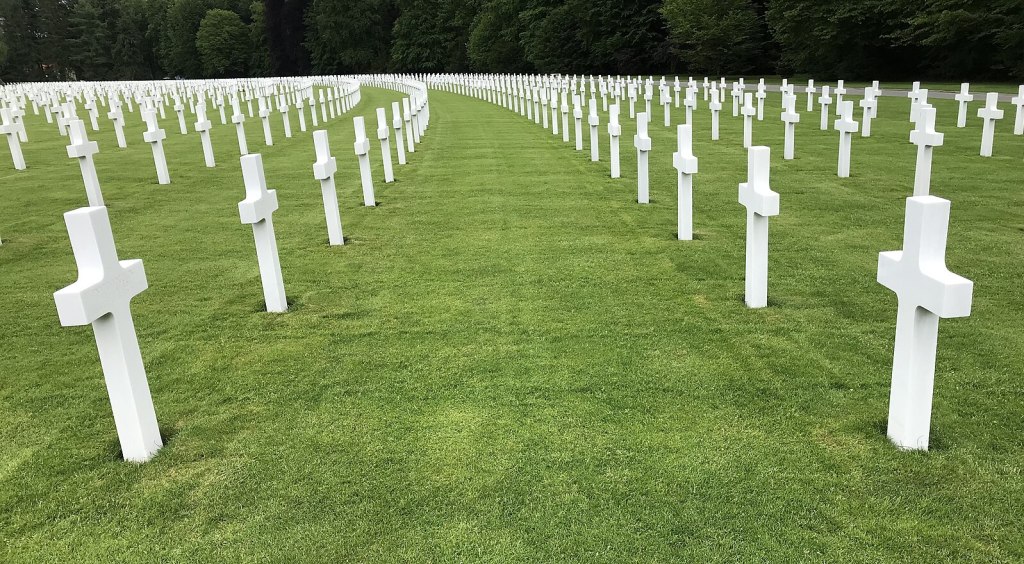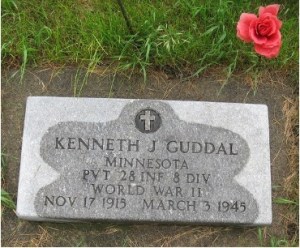This year, when my father’s name is announced along with others from World War II, I will step forward and place that red carnation at the base of his white cross.
Mid-week I’ll load the Jeep with a few things including food for Cora Jolene, the Dog. We will make a pilgrimage, a road-trip, some 14 hours, back to Minnesota, Cottonwood County, back in time, back in history.
And in time for Memorial Day this year May 26, 2025 which my father always called “Decoration Day.”
On the Sunday before, the American Legion and Auxiliary will assemble and assignments will be given. Folks will fan out and visit cemeteries and on the graves of departed veterans American flags will sprout.
I will be there to help.
And then with many others including Boy Scouts and Cub Scouts, off to a warehouse where white crosses are stored. They will be carefully loaded into pick-up truck beds and driven to the city park where they will be unloaded and then carefully arranged in rows with one who lost his life in the Spanish American War placed first.
It’s preparation for Monday’s Memorial Day in which following church services there will come the march to the city park and tribute will be paid.
And by March I mean American Legion members in uniform dress followed by, well, followed by citizens.
When a name is announced someone, often a young person, will step forward and place a fresh red carnation at the base of that white cross.
This year, when my father’s name is announced along with others from World War II, I will step forward and place that red carnation at the base of his white cross.
I suspect I will not make the trip again what with age and all creeping along. Best to make this remembrance now.
*****
Roy Peterson married Anna Olson in 1906; over the years, this married couple brought into the world five girls and one boy. Roy was a literary man with a sense of humor. He named his one son Raoul Delmar, nick-named “Yank,” the reason and the story you already know. His oldest daughter, Luella Ophelia, or “Lue,” and all of this in Minnesota where such humor abounds only haphazardly
I have two photographs taken on their 35th wedding anniversary. One photograph shows the entire family in a festive mood, laughing and smiling. My own mother, Eileen Aurel, is looking down and away with unabashed happiness.
In the second picture, their faces are sober as if something has taken away their festiveness this December 7th in 1941.
It’s history, is it not?
Something sobering about this spot of time, an historical touchstone.
In the “historical” time between the two photographs, the news about Pearl Harbor arrived, broadcast over the radio in the photographer’s studio. Raoul was scheduled to be inducted in January; the five sisters were all married and with the exception of Luella had husbands in the service, including my own father stationed then on Kodiak Island twelve months after his National Guard unit had been called up, January or so in 1941.
Four of the sisters decided to live together in a rented home in White Bear Lake, Minnesota. Someone would always be around to “sit” children while others would go off to work. I once asked my mother what the best of times were like and the worst of times
She simply said, “It was when the mail came.”
I know some things about this as I remember suffering through summer family reunions held in the village park of Ruthven, Iowa. After the slow pitch softball, the horse shoe competitions, the long leisurely picnic, out would come the lawn chairs arranged in circling tiers, the older folks in front usually around great-grandmother Rasmussen (neé Ravn), then the next generation of her children, and then their children, and so on, but interestingly the very youngest of all sprawled in front, listening, picking clovers. As I said, I know some things about this. And it would start, pictures handed around which would prompt and then prompt again all those memories and each the basis of a story made familiar with time and repetition.
It’s history, is it not?
My mother and I were together, years later, about a decade after my father’s death. Hawaii, it was, Oahu, Pearl Harbor, and the Arizona Memorial. She stands, my mother, facing my camera, and pointing to the list of names memorialized: 1,102 inscriptions on marble. She could be pointing to all of them, but she’s actually pointing to one name, Halge Hijem Smestad, RM2c, USN, Minnesota, entombed below that memorial.
So, I asked her about this Halge Smestad and whom he happened to be. “Oh,” she said, “He was just a Dovray boy.”
Westbrook Minnesota, is between two other small Minnesota towns, Storden to the east and Dovray to the west. There was or is something about Westbrook girls because Dovray boys and Storden boys were more apt than not to cruise east and west in search of, shall we say, romance in Westbrook.
And as the story goes, my mother had been dating that Dovray boy before she met my father, smitten as she was with him more than Halge. She threw him over. And that Dovray boy joined the navy which is what boys do when they are thrown over, losers in the age-old drama of romance.
And so, back to that picture, that December 7, 1941 picture, and I think today of the change especially in my mother’s face: from the look down and the unabashed laughter before that radio broadcast moment took that open and happy smile away. That day brought worry and soon the news that Halge was entombed.
One would have to search the inner recesses of her thoughts at that moment, thoughts which must have penetrated the recesses of her heart and soul. And it’s more complicated: She would travel by train to meet my father in Seattle in a matter of a few months and my sister Rebecca would be along having become born that September in 1941. They would meet in Seattle for a few days before he would arrive in El Paso for automatic weapons training out there in that southwestern desert.
It’s history again is it not, compounded and complicated–and personal. It’s not written in those history textbooks but just because it’s not written in those textbooks doesn’t mean it’s not important or doesn’t have a philosophical shape.
I think of that Dovray boy, that Halge, every Memorial Day. I’m obliged, I guess. My last name could have been Smestad.
And so I remember how on the evening before every Memorial Day in that small Minnesota town members of the American Legion would assemble in the village park and arrange white crosses row-on-row, more added every year, the newer ones again more white than the older ones.
*****
On as with past Memorial Days, there will then be a memorial service in the high school auditorium just across the street, then a solemn assembly of flags, cub scouts, brownies, boy scouts, girl scouts, a couple of eagle scouts, and after the service a slow march to that village park, the village folks led by flags and all–a slow march as I said, muffled drums, a melancholy beat.
A prayer would be had, and then my father those years ago would read the roll call names of the dead beginning from a considerable way back in time and then forward in time and forward in history, that word again: his story….
But not now, not this year; someone else will read the names and this someone more likely than not a Vietnam veteran.
It’s been years since I’ve been back but I have this sort of spiritual tug, a call, time to go back or so I think.
When a name was read, a scout or someone would walk forward and place a real red carnation beneath that cross. And then after all the names had been read and the red carnations laid at the bases of those crosses, there would be a three volley salute and in the far corner of that village park someone from the high school band would blow taps, a custom signaling the dead and wounded were to be removed.
And then the slow procession to another area in the small village park for a village picnic. Some would linger, mostly veterans, or widowed wives, and my own father who would linger before one cross upon which was the name Kenneth Guddal, 28th Infantry, 8th Division, dead on March 3, 1945, age 29, about nine months after landing on Utah Beach, and a few days after crossing the Erft Canal and the shore of the Rhine before advancing into the Rhineland.
I know this story because my own father was there with Kenneth, his childhood friend and the two of them together all those years, and Kenneth best man at the wedding of my mother and father. Poignant then when in a quiet moment during that war, that March 11 day, when came a sniper’s bullet and Kenneth was dead.
It was what the Germans were doing in retreat–leaving snipers behind, hidden in the rubble, rubble which could be a synonym for history. Whatever: I know today my old father knew some things about that underbelly to history, as did my mother that December day in 1941.
And so my father would linger every Memorial Day between those crosses row-on-row with his thoughts and those thoughts must have been profound and melancholy and deep….
*****
I shall do the same this year, linger between the crosses row-on-row, homage and love for my father and close by, Kenneth….
THE PISGAH VISION
My father’s friend, Kenneth Guddal, was a good
Coronet player, dead in the war, spring 1945 or so,
Brought home, buried in Amo Lutheran underneath
One of those standardized military markers.
Every Memorial Day I think of Kenneth Guddal,
Thinking of a voice I’ve never heard, a young
Girl waiting in a field, spring, summer, 1941 or so.
She leads Kennth across a field to where cows
Lift their heads from centuries of grass; Kenneth
And the girl lie naked as new grave stones by the
Stream, the earth warm as their need. She looks
Out the window through the lattices, remembering
How he turned her on her stomach, touched the blades
Of her shoulders: That’s good, she says, good.
__________
From A Memoir In Progress: The Man Who Balanced A Tea Cup On His Head And Other Fugitive Pieces
The Imaginative Conservative applies the principle of appreciation to the discussion of culture and politics—we approach dialogue with magnanimity rather than with mere civility. Will you help us remain a refreshing oasis in the increasingly contentious arena of modern discourse? Please consider donating now.
The featured image, uploaded by Dudva, is a photograph of the Luxembourg American Cemetery and Memorial, a Second World War American military war grave cemetery, located in Hamm, Luxembourg City, Luxembourg. This file is licensed under the Creative Commons Attribution-Share Alike 4.0 International license, courtesy of Wikimedia Commons.














